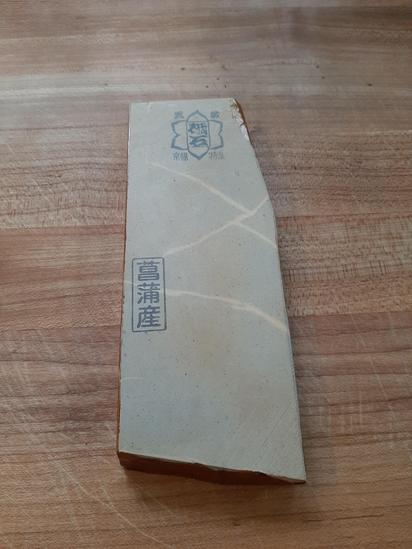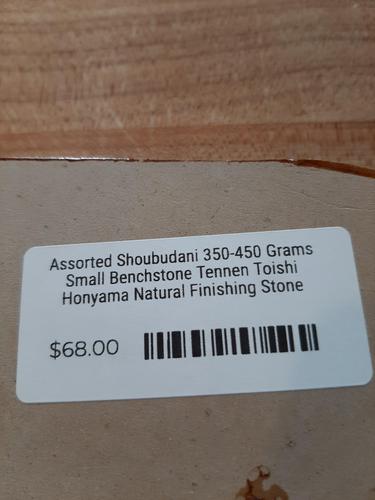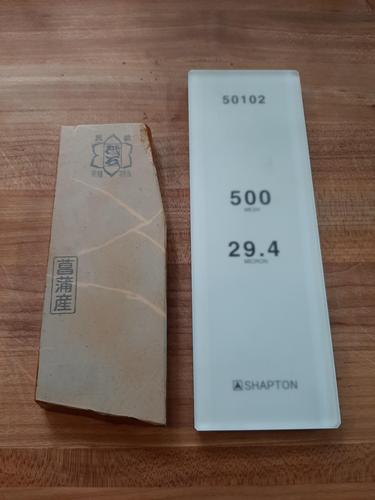MowgFace
Senior Member
Where can I get one of these?
I got mine from eBay. Searched the model number. Ran me around ~225USD +shipping. Came with both stones

Where can I get one of these?
Depends on how you use them. They feel like Japanese water stones, and they definitely wear. At some point you will 100% have to flatten them.Do they wear unevenly? i would assume that those stones don’t need to be flattened.
I wonder how fast I'd turn a cleaver into a nakiri.
lol both

I've managed to find a few knife shops in Antalya, Turkey while on a holiday. Picked up a few local natural stones, which I believe are Cretans. However, one shop owner told me they are called Girit stone (based on what I heard. Not sure hot it is spelled). They are pretty cheap in Turkey. I've paid around 15 USD for the shorter stone and around 3 USD for the longer one. They were bough from different shops in Antalya. One shop keeps said that they are oil stones.
They look pretty similar when dry, however after you wet them they look pretty different. The shorter stone looks like having more different looking elements/particles while the longer one is more uniform. The shorter stone has more grey/blue colour and the longer one is more of a blue/purple. To the touch they feel pretty similar, pretty hard and medium to medium-fine grit level. I've not had a chance to sharpen anything on them yet.
Has anyone had much experience with these stones? What are they good for? Knives or razors or both? Also, can they be used with water and not oil? I am not a big fan of oil to be honest and try to avoid using oil.
Cheers

Ohhhh man hold on to your wallet/retirement fund!!!My first toe dip into JNATs.





One year after starting the search.. uchigumori. Thank you @nutmeg, it’s absolutely stunning. Killer edges, something less expected from uchi in general. View attachment 183397
It’s the reason I couldn’t buy that okudu of yours! I do have to say I may have been shopping with my eyes with this one.. the colors and renge are wild, and the mud comes up a dark pink.I actually quite like the edges I get off my Uchi as well. They're slow to form for sure, but high quality once there in my experience.
That stone has me drooling...
That's pretty gorgeous eh!
Look forward to seeing the very spiffy results you'll no doubt coax out of it.












A follow up with some more pictures of the Turkish stones which Ive recently got from a few shops in Antalya a week or so ago. I've done a bit of silicon carbide work on them and finished with 400 Atoma. One of the stones seem to have a lot of inclusions which are gold colour. I wonder what those inclusions could be and if they are toxic in the knife sharpening/polishing sense? @cotedupy do you know what could they be? A close up 40x pictures below with the gold colour inclusion at the bottom half of the picture..
The wider and longer stones seem to be a bit higher grit compared with the shorter and higher stones. Apart from that they seem to have a very similar structure.
I am yet to put a steel on them, bit intend to do so over the next few weeks.

Hello. I picked up a Dan’s hard ark, 8x3x1, last week. They come with a pretty rough surface so I lapped it to 2000 grit SiC, rubbed it with a Tsushima nagura and sharpened two knives. There is a bit of reflection in the surface now. This is a very good stone IMHO, but a little on the pricey side.View attachment 183867
Thanks. I was planning to give them a spin tonight if I wouldn't be knackered. Will update the thread.Very cool looking stones! Look forward to hearing how they perform.
The gold inclusions are almost certainly pyrite, which may or may not be a problem. The top end of pyrite hardness is around the same level as the top end of knife steel hardness I believe. Though in general - it's going to be a little below that of good quality Japanese steels, so shouldn't be too much of a problem or issue for sharpening. It will though scratch softer steel/cladding.
I've had and have stones with small pyrite inclusions with no problems whatsoever. (Quartz inclusions for example can be more of an issue).
Yes. The stone is clean and dry in this picture. The white dot in the center is the reflection of the light above.I assume the funky colouring is in the stone itself rather than being something from the Tsushima...? Cool!
I would like to do the comparison occasionally! I'm curious about your impressions when you use them...I was curious about SG HC vs HR, so I ordered a 4000 HC and a 8000 HC – the grey ones supposedly preferable for carbon, 50603 and 50803.
They arrived today with a usage note in Japanese. I'll share that for posterity, plus the Google Translate version.
Stones from left to right, 2000 HR, 4000 HC, 8000 HC.
Haven't heard much about them, good?
Ooh! What's that?
Enter your email address to join: